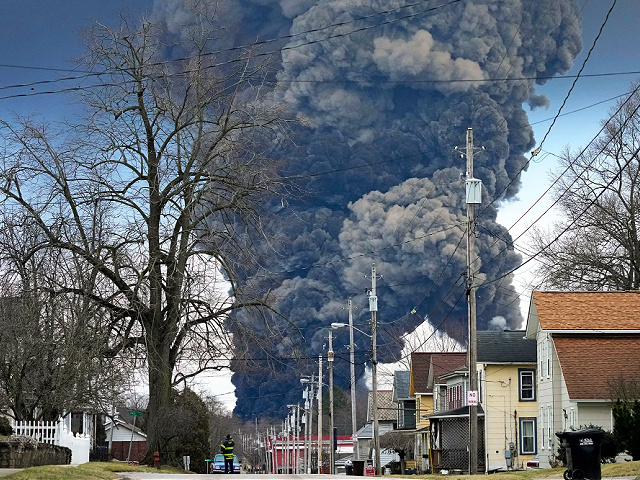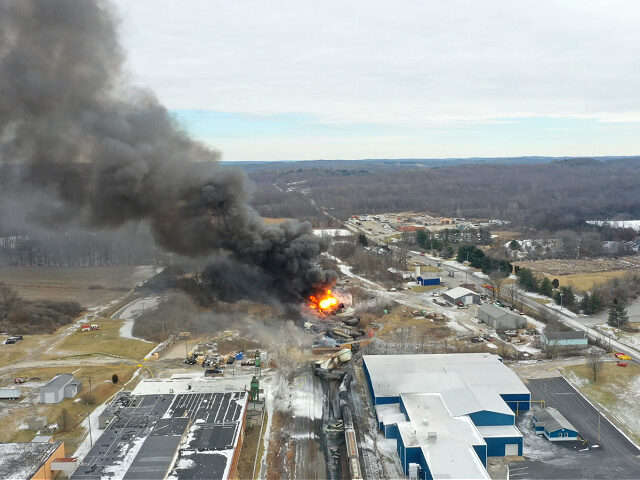Sens. J.D. Vance (R-OH) and Sherrod Brown (D-OH) directed a letter to the Environmental Protection Agency (EPA) and the Ohio Environmental Protection Agency (OPEA) asserting it “does not appear that” the agencies or Norfolk Southern are monitoring for dioxins in East Palestine, Ohio.
Vance and Brown wrote the letter to U.S. EPA Administrator Michael Regan and OPEA Director Anne Vogel on Saturday, following the February 3 train derailment on a Norfolk Southern rail and a subsequent controlled burn of vinyl chlorine that was in multiple cars. The burn was conducted after the chemicals had reached a dangerous temperature in the days after the crash and posed the threat of an explosion that could have sent shrapnel up to a mile away, as Gov. Mike DeWine (R-OH) said the day of the release, as Breitbart News reported.
The Ohio senators expressed gratitude for “the extensive air monitoring U.S. EPA has undertaken related to vinyl chloride and several known by-products that are produced when vinyl chloride burns including phosgene and hydrogen chloride,” before raising concerns about dioxins.

A black plume rises over East Palestine, Ohio, as a result of the controlled detonation of a portion of the derailed Norfolk and Southern trains Monday, Feb. 6, 2023. (AP Photo/Gene J. Puskar)
“However, following our visits to East Palestine this past week where we heard directly from members of the community, we remain concerned that it does not appear that the U.S. EPA, OEPA, or Norfolk Southern is texting for dioxins,” Vance and Brown continued before laying out a list of question for the agencies:
- Has either the OEPA and/or U.S. EPA been monitoring the air for dioxins?
- If not, please explain why the OEPA and/or U.S. EPA has not been monitoring for dioxins?
- Is the OEPA or U.S. EPA aware of any other entity that may be monitoring for dioxins, including Norfolk Southern?
- Are there additional resources or authorities that OEPA or U.S. EPA needs in order to undertake regular monitoring for dioxins in East Palestine and the surrounding community?
- Does OEPA or U.S. EPA have a system set up for members of the community and other expert stakeholders to engage on the testing and monitoring regimen following the train derailment and subsequent activities in East Palestine to ensure a thorough, comprehensive response to monitor the area for potential pollutants? If not, will you commit to establishing appropriate protocol to ensure engagement?
- If dioxins are detected in the region, what are OEPA’s and U.S. EPA’s respective protocols for communicating with the local community, addressing the potential contaminant(s), and protecting the local community from potential long-term exposure?
The World Health Organization (W.H.O.) notes that dioxins are environmental pollutants with the potential to be “highly toxic” as “[e]xperiments have shown they affect a number of organs and systems.”
Dioxins have robust chemical stability, and their “half-life in the body is estimated to be 7 to 11 years,” according to the W.H.O.
Exposure to high levels of dioxins in the short term can yield “skin lesions, such as chloracne and patchy darkening of the skin, and altered liver function,” the W.H.O. notes. “Long-term exposure is linked to impairment of the immune system, the developing nervous system, the endocrine system and reproductive functions.”

COMMENTS
Please let us know if you're having issues with commenting.